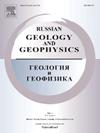Volumetric Structure of the Bachat Earthquake (Kuzbass) Aftershock Area and Stress State of Rock Mass under Open-Pit Mine
IF 1
4区 地球科学
Q3 GEOSCIENCES, MULTIDISCIPLINARY
引用次数: 0
Abstract
Abstract —The Bachat earthquake (M = 6.1) with the epicenter coordinates of 54.29° N, 86.17° E occurred on June, 18 2013 near the Bachatsky coal strip mine, is the world’s largest earthquake induced while mining solid minerals. More than 5000 aftershocks were registered and the spatial volumetric structure of the aftershock area was investigated. The Bachat coal field is located in the Salair zone of the Kuznetsk Depression and is represented by a brachysynclinal fold of a very complex structure characterized by the damage and fracturing behaviors of rocks. The main event is confined to the coal-mine pit wall, with the greatest density of aftershocks observed in its middle portion. In the cross section, aftershocks form a wide area with its deepened portion shifted towards the Kuznetsk Depression, while large faults bounding the depression dip down under the Salair Ridge. In the exposed pit wall, at a depth of 4 km, the activated area resembles a rhombus whose horizontal diagonal line runs across the entire length of the mine pit and decreases both in upward and downward directions. The area is seismically activated to a depth of 6 km, with more intense activation of rock mass observed within the 1–3 km depth interval. Results of the study of the mechanisms of aftershock sources revealed a disagreement between the stress state of rock mass of the Bachatsky open-pit coal mine modeled from the mechanisms of aftershocks, and the mainshock mechanism of the Bachat earthquake.巴恰特地震(库兹巴斯)余震区体积结构与露天矿岩体应力状态
摘要2013年6月18日发生在Bachatsky露天煤矿附近的巴恰特地震(M = 6.1),震中坐标为54.29°N, 86.17°E,是世界上最大的固体矿物开采诱发地震。记录了5000多次余震,并对余震区的空间体积结构进行了调查。Bachat煤田位于库兹涅茨克坳陷Salair带,是一个以岩石损伤和破裂行为为特征的构造非常复杂的短斜褶皱。主要地震活动局限于煤矿坑壁,在其中部观测到的余震密度最大。在横截面上,余震形成大面积,其加深部分向库兹涅茨克坳陷方向移动,而与坳陷交界的大断裂则在Salair Ridge下倾。在4 km深的露天矿围岩中,激活区呈菱形,其水平对角线贯穿整个矿坑长度,向上和向下均递减。该地区的地震激活深度为6公里,在1-3公里深度范围内观察到更强烈的岩体激活。余震震源机制研究结果表明,余震机制模拟的Bachatsky露天煤矿岩体应力状态与Bachatsky地震主震机制不一致。
本文章由计算机程序翻译,如有差异,请以英文原文为准。
求助全文
约1分钟内获得全文
求助全文
来源期刊

Russian Geology and Geophysics
地学-地球科学综合
CiteScore
2.00
自引率
18.20%
发文量
95
审稿时长
4-8 weeks
期刊介绍:
The journal publishes original reports of theoretical and methodological nature in the fields of geology, geophysics, and geochemistry, which contain data on composition and structure of the Earth''s crust and mantle, describes processes of formation and general regularities of commercial mineral occurrences, investigations on development and application of geological-geophysical methods for their revealing. As to works of regional nature, accelerated publication are available for original papers on a variety of problems of comparative geology taking into account specific character of Siberia, adjacent Asian countries and water areas. The journal will also publish reviews, critical articles, chronicle of the most important scientific events, and advertisements.
 求助内容:
求助内容: 应助结果提醒方式:
应助结果提醒方式:


